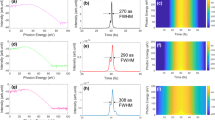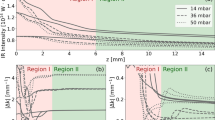Abstract
High harmonic generation is a phenomenon that occurs when an atom is subjected to a strong laser field. The laser field must have an intensity of at least \({10}^{14}\) \(\mathrm{W}/{\mathrm{cm}}^{2}\) to cause tunnel ionization, which releases an electron from the nucleus and allows it to gain energy by moving in the laser field. Upon recombining with the parent ion, the electron radiates its kinetic energy as photons in the XUV region. In this study, In order to find the optimal intensity of each atom, we first simulate and investigate the ionization probability of the noble gas atom. The simulation results show that the saturation intensity of tunnel ionization is about 3.8, 6, 8.1 and 12.5 × \({10}^{14}\) \(\mathrm{W}/{\mathrm{cm}}^{2}\) for xenon, argon, neon and helium gases, respectively. Using these results, we have been able to obtain the appropriate intensities to produce optimal attosecond pulses for each atoms. Then, according to the saturation intensity of gas ionization, we simulate the high-order harmonic spectrum in three intensities of 3, 5, and 8 × \({10}^{14}\) \(\mathrm{W}/{\mathrm{cm}}^{2}\) and investigate the effects of atomic and laser parameters on the cut-off point and plateau region of high harmonic generation spectrum. The simulation results show that the intensity and time profile of attosecond pulses are highly dependent on \({I}_{P}\), and only the atoms that are in the range of tunnel ionization produced attosecond pulses. Also, our simulation results indicate that increasing the intensity leads to higher cut-off points and plateau regions for the harmonics. Furthermore, we found that helium had the highest cut-off point and plateau region at all three intensities, making it the most efficient noble gas for high harmonic generation.






Similar content being viewed by others
References
C.H. Zhang, X. Zhou, Y. Wen, Y. He, The way to generating sub-femtosecond pulse trains with high-order stimulated Raman scatterings. Mod. Phys. Lett. B 36, 2250162 (2022)
S. Camp, S. Beaulieu, K.J. Schafer, M.B. Gaarde, Resonantly-initiated quantum trajectories and their role in the generation of near-threshold harmonics. J. Phys. B 51, 064001 (2018)
H.K. Avetissian, G.F. Mkrtchian, A. Knorr, Efficient high-harmonic generation in graphene with two-color laser field at orthogonal polarization. Phys. Rev. B 105, 195405 (2022)
H.A. Navid, M. Keshavarzi, Optimal control of high harmonics for the generation of double attosecond pulses by using a chirped laser pulse. J. Mod. Opt. 64, 2117 (2017)
P. Corkum, Attosecond pulses at last. Nature 403, 845 (2000)
S. Majidi, R. Aghbolaghi, A.H. Navid, Probability of ionization of the noble gas atoms and ions for high harmonic generation. Mod. Phys. Lett. B 37, 2350039 (2023)
S. Majidi, R. Aghbolaghi, High harmonic generation from H2He2+ molecules in plasmonic field. ICOP ICPET 25, 889–892 (2019)
V.V. Strelkov, V.T. Platonenko, A.F. Sterzhantov, M.Y. Ryabikin, Attosecond electromagnetic pulses: generation, measurement, and application Generation of high-order harmonics of an intense laser field for attosecond pulse production. Phys. Uspekhi 59, 425 (2016)
M. Lewenstein, P.H. Balcou, M.Y. Ivanov, A. Luillier, P.B. Corkum, Theory of high-harmonic generation by low-frequency laser fields. Phys. Rev. A 49, 2117 (1994)
Z. Chang, Fundamentals of Attosecond Optics (CRC Press, Taylor & Francis Group, 2011)
M.V. Ammosov, N.B. Delone, V.P. Krainov, Tunnel ionization of complex atoms and atomic ions in electromagnetic field. SPIE 0664, 138 (1986)
M. Ammosov, N. Delone, V. Krainov, Tunnel ionization of complex atoms and of atomic ions in an alternating electromagnetic field. Sov. Phys. JETP 64, 1191 (1986)
Z. Chang, A. Rundquist, H. Wang, M.M. Murnane, H.C. Kapteyn, Generation of coherent soft X rays at 27 nm using high harmonics. Phys. Rev. Lett. 79, 2967 (1997)
B. Fetic, K. Kalajdzic, D.B. Milosevic, High-order harmonic generation by a spatially inhomogeneous field. Ann. Phys. (Berlin) 525, 107 (2013)
H.A. Navid, R. Aghbolaghi, Z. Yarali, Generation of carrier-envelope phase-controlled isolated attosecond pulses using chirped femtosecond excitation lasers. J. Mod. Opt. 66, 1744 (2019)
M. Delfour, M. Fortin, G. Payr, Finite-difference solutions of a non-linear Schrödinger equation. J. Comput. Phys. 44, 277 (1981)
I.W. Sudiarta, D.J. Geldart, Solving the Schrödinger equation using the finite difference time domain method. J. Phys. A: Math. Theor. 40, 1885 (2007)
T. Brabec, Strong Field Laser Physics (Springer, Cham, 2008)
V.V. Strelkov, A.F. Sterjantov, S.N. Yu, V.T. Platonenko, XUV generation with several-cycle laser pulse in barrier-suppression regime. J. Phys. B 39, 577 (2006)
Author information
Authors and Affiliations
Contributions
SM performed the numerical simulations, analysed the results, and wrote the manuscript. RM edited it in terms of grammar and writing. RA and HAN provided critical feedback, supported the analysis of the results, and improved the final version of the manuscript.
Corresponding author
Ethics declarations
Conflict of interest
The authors declare that they have no conflicts of interest.
Additional information
Publisher's Note
Springer Nature remains neutral with regard to jurisdictional claims in published maps and institutional affiliations.
Rights and permissions
Springer Nature or its licensor (e.g. a society or other partner) holds exclusive rights to this article under a publishing agreement with the author(s) or other rightsholder(s); author self-archiving of the accepted manuscript version of this article is solely governed by the terms of such publishing agreement and applicable law.
About this article
Cite this article
Majidi, S., Aghbolaghi, R., Navid, H.A. et al. Optimization of cut-off frequency in high harmonic generation in noble gas. Appl. Phys. B 130, 11 (2024). https://doi.org/10.1007/s00340-023-08139-z
Received:
Accepted:
Published:
DOI: https://doi.org/10.1007/s00340-023-08139-z




